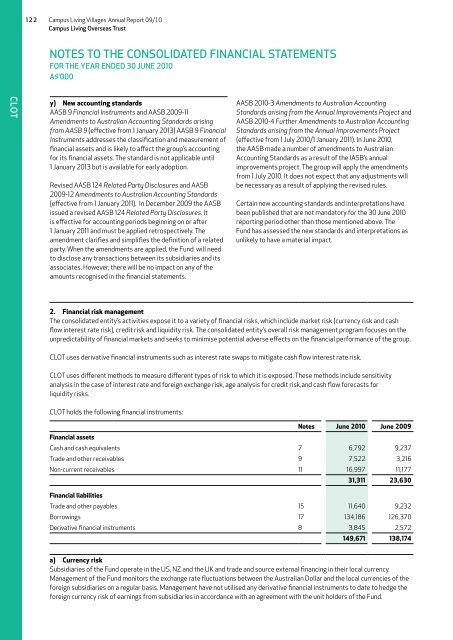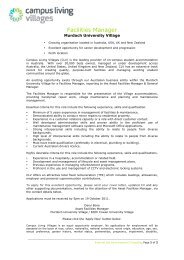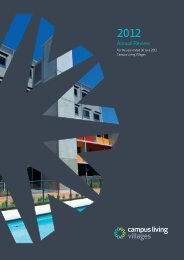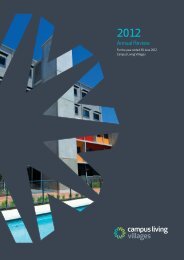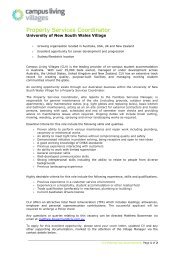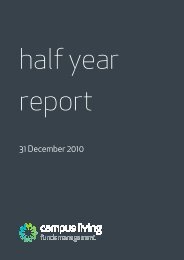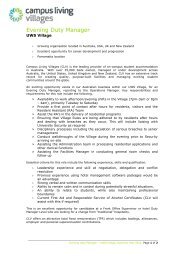Annual Report - Campus Living Villages
Annual Report - Campus Living Villages
Annual Report - Campus Living Villages
You also want an ePaper? Increase the reach of your titles
YUMPU automatically turns print PDFs into web optimized ePapers that Google loves.
1 2 2 <strong>Campus</strong> <strong>Living</strong> <strong>Villages</strong> <strong>Annual</strong> <strong>Report</strong> 09/10<br />
<strong>Campus</strong> <strong>Living</strong> Overseas Trust<br />
NOTES TO THE CONSOLIDATED FINANCIAL STATEMENTS<br />
FOR THE YEAR ENDED 30 JUNE 2010<br />
A$’000<br />
CLOT<br />
y) New accounting standards<br />
AASB 9 Financial Instruments and AASB 2009-11<br />
Amendments to Australian Accounting Standards arising<br />
from AASB 9 (effective from 1 January 2013) AASB 9 Financial<br />
Instruments addresses the classification and measurement of<br />
financial assets and is likely to affect the group’s accounting<br />
for its financial assets. The standard is not applicable until<br />
1 January 2013 but is available for early adoption.<br />
Revised AASB 124 Related Party Disclosures and AASB<br />
2009-12 Amendments to Australian Accounting Standards<br />
(effective from 1 January 2011). In December 2009 the AASB<br />
issued a revised AASB 124 Related Party Disclosures. It<br />
is effective for accounting periods beginning on or after<br />
1 January 2011 and must be applied retrospectively. The<br />
amendment clarifies and simplifies the definition of a related<br />
party. When the amendments are applied, the Fund will need<br />
to disclose any transactions between its subsidiaries and its<br />
associates. However, there will be no impact on any of the<br />
amounts recognised in the financial statements.<br />
AASB 2010-3 Amendments to Australian Accounting<br />
Standards arising from the <strong>Annual</strong> Improvements Project and<br />
AASB 2010-4 Further Amendments to Australian Accounting<br />
Standards arising from the <strong>Annual</strong> Improvements Project<br />
(effective from 1 July 2010/1 January 2011). In June 2010,<br />
the AASB made a number of amendments to Australian<br />
Accounting Standards as a result of the IASB’s annual<br />
improvements project. The group will apply the amendments<br />
from 1 July 2010. It does not expect that any adjustments will<br />
be necessary as a result of applying the revised rules.<br />
Certain new accounting standards and interpretations have<br />
been published that are not mandatory for the 30 June 2010<br />
reporting period other than those mentioned above. The<br />
Fund has assessed the new standards and interpretations as<br />
unlikely to have a material impact.<br />
2. Financial risk management<br />
The consolidated entity’s activities expose it to a variety of financial risks, which include market risk (currency risk and cash<br />
flow interest rate risk), credit risk and liquidity risk. The consolidated entity’s overall risk management program focuses on the<br />
unpredictability of financial markets and seeks to minimise potential adverse effects on the financial performance of the group.<br />
CLOT uses derivative financial instruments such as interest rate swaps to mitigate cash flow interest rate risk.<br />
CLOT uses different methods to measure different types of risk to which it is exposed. These methods include sensitivity<br />
analysis in the case of interest rate and foreign exchange risk, age analysis for credit risk,and cash flow forecasts for<br />
liquidity risks.<br />
CLOT holds the following financial instruments:<br />
Notes June 2010 June 2009<br />
Financial assets<br />
Cash and cash equivalents 7 6,792 9,237<br />
Trade and other receivables 9 7,522 3,216<br />
Non-current receivables 11 16,997 11,177<br />
31,311 23,630<br />
Financial liabilities<br />
Trade and other payables 15 11,640 9,232<br />
Borrowings 17 134,186 126,370<br />
Derivative financial instruments 8 3,845 2,572<br />
149,671 138,174<br />
a) Currency risk<br />
Subsidiaries of the Fund operate in the US, NZ and the UK and trade and source external financing in their local currency.<br />
Management of the Fund monitors the exchange rate fluctuations between the Australian Dollar and the local currencies of the<br />
foreign subsidiaries on a regular basis. Management have not utilised any derivative financial instruments to date to hedge the<br />
foreign currency risk of earnings from subsidiaries in accordance with an agreement with the unit holders of the Fund.


